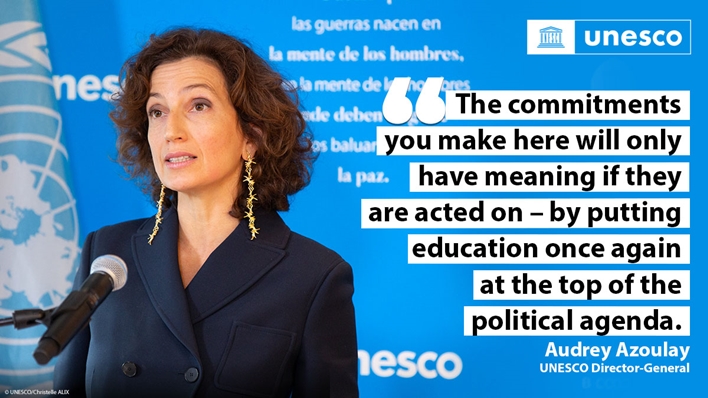Blog by Evelyne Para, SI UN Representative at The United Nations Educational, Scientific and Cultural Organisation (UNESCO).
On 13 July, the UNESCO Global Education Meeting (GEM 2021) was held, with a ministerial segment on the sidelines of the High Level Political Forum for Sustainable Development. Entitled From Recovery to Accelerating Progress on SDG 4, GEM 2021 recalled that education is undoubtedly a cross-cutting element and a driving force of the 2030 Agenda. The meeting emphasised the importance of building on partnerships and innovations that the global education community has put in place to respond to COVID-19 pandemic to ensure a sustainable, resilient and inclusive recovery.
The gap is widening between two educational worlds
This annual meeting organised by UNESCO was crucial in 2021 to assess the impact of the pandemic on this fundamental human right of education, and also to improve international cooperation in this area. Today, many educational inequalities are widening between and within countries. This is confirmed by a new study carried out in 2021 in 142 countries by UNESCO in partnership with UNICEF, OECD and World Bank. The results published on GEM 2021 occasion show that the gap between two educational worlds is likely to continue to widen and that four educational divides have worsened since COVID-19 pandemic:
– First of all, there is unequal access to learning. In 2020, schools closed twice as much on average in low and middle income countries as in high income countries. When looking at the total global population of students enrolled in education systems, the study shows that more than 89% have dropped out of school due to closures linked to COVID-19. This represents 1.54 billion children and young people enrolled in school or university, of which nearly 743 million are girls.
– The second divide is the digital one. Only a quarter of low and middle income countries have been able to develop a truly operational digital learning policy, compared with half in high income countries. This is part of the reason why 500 million students around the world were deprived of distance learning during the pandemic.
– The third divide is the one that exists and persists between genders. In less advantaged countries, girls dropping out of school is a persistent issue. They run more risks of not going back to school, whilst also facing risks of sexual exploitation, early pregnancies, forced marriages etc. The pandemic has seriously worsened household poverty, and because of the economic difficulties linked to health crisis, families have had to reconsider the cost of schooling of their children. As a result, the pandemic has resulted in a significant increase in marriages of teenage girls in some countries. Although child marriages are almost universally prohibited, there are 33,000 each day around the world. The COVID-19 pandemic is expected to lead to 13 million more girls teenage marriages by 2030. That is why we must continue to make girls’ education a priority!
– Finally, a fourth divide is worsening: the budgetary divide. Only half of the countries have increased their education budgets in the face of the pandemic.

Amina Mohammed, UN Deputy Secretary-General, talks at the Global Education Meeting 2021.
We must act collectively
“Act first to reopen schools safely. Schools should be the first places to reopen, and the last to close. To this end, therefore it’s important to vaccinate teachers as a priority”, said Audrey Azoulay, Director-General of UNESCO. In addition, we know that the vaccine divide between the Global North and Global South, where only 1% of the 3.3 billion doses of vaccines have been administered in the poorest countries, and this divide also threatens the continuity of education in those countries.
Taking action also means evaluating and closing the gaps. Whilst 100 million students worldwide could fall below the minimum reading proficiency threshold, and that number has been worsened by the pandemic, we know that 11 more years will be needed to catch up. Therefore it will be necessary to offer specific upgrading programmes to close this gap.
UNESCO defends gender equality in education
Too many girls and women are still held back by social norms and traditional school practices that affect their rights and educational opportunities. Yet we know that their education represents the most powerful investment in our collective future.
This is why during this GEM 2021, UNESCO wished to recall certain priority actions to be pursued for girls and women:
- The campaign Her education, our future, launched by UNESCO, aims to accelerate efforts towards girls’ and women’s education based on political and financial commitments, as well as on leadership of girls and women.
- This campaign contributes to UNESCO strategy for gender equality in and through education 2019-2025 based on three main pillars: collecting better data to underpin action for gender equality in and through education; implementing better legal, policy and planning frameworks to advance girls’ and women’ rights; and better learning opportunities to empower girls and women.
- Following COVID-19, we also need to rebuild equality through gender-responsive actions that transform education systems, prioritise resilience and address barriers to girls’ education. For example, we must continue to offer different forms of distance learning, such as radio and television programmes, in disadvantaged regions. These programmes promote educational continuity and positively influence the way families and community look at girls’ education. They must challenge negative social norms and promote gender equality.
For concluding this GEM 2021, representatives of the different countries proposed Recommendations that will be validated at the next meeting scheduled at UNESCO in November 2021.
To find out more, watch the recorded highlights of the GEM 2021 HERE.
(Lead photo: UNESCO).

